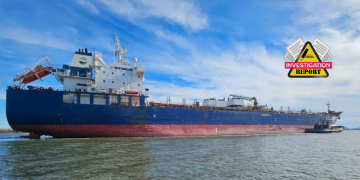The National Transportation Safety Board (NTSB) has released an investigation report on an incident where the Francis Scott Key Bridge in Baltimore collapsed following a collision with the container ship MV Dali, creating a major impact in US trade and port operations.
The incident
On March 26, 2024, about 0129 eastern daylight time, the 947-foot-long Singapore-flagged cargo vessel (containership) Dali was transiting out of Baltimore Harbor in Baltimore, Maryland, when it experienced a loss of electrical power and propulsion and struck the southern pier supporting the central truss spans of the Francis Scott Key Bridge (Key Bridge). A portion of the bridge subsequently collapsed into the river, and portions of the deck and the truss spans collapsed onto the vessel’s forward deck. A seven-person road maintenance crew employed by Brawner Builders—which was contracted by the Maryland Transportation Authority (MDTA)—and one inspector employed by Eborn Enterprises, Inc., a subconsultant to the MDTA, were on the bridge when the vessel struck it. The inspector escaped unharmed, and one of the construction crewmembers survived with serious injuries. The bodies of the six fatally injured construction crewmembers have been recovered. One of the 23 persons aboard the Dali was injured.
Analysis
Dali’s Main Propulsion System
The Dali was propelled by a single, slow-speed, 55,626-hp (41,480-kW) diesel engine manufactured by Hyundai MAN B&W. The engine was directly connected to a single, right-turning propeller. To run the main engine, one of the vessel’s four diesel generators must be operating and supplying the vessel with electrical power. The emergency generator alone cannot be used to restart or run the main engine. The Dali’s main engine required compressed air directed into its cylinders to start and change direction. To change from ahead (moving forward) to astern (moving in reverse), the engine would need to be stopped and then restarted in the opposite direction.
The engine was also fitted with alarms and automatic shutdown features to prevent damage to the engine if supporting systems required for its operation, such
as the lubricating oil pump (which controls lubricating-oil pressure) or cooling water pump (which supplies a flow of cooling water), were lost. If a loss of electrical power occurred to either of these pumps, the engine would be shut down automatically. As part of a multistep sequence to restart and operate the main engine after a shutdown, the lubricating oil and cooling water pumps would need to be restarted.
Dali’s Electrical Power Distribution System
The ship’s electrical power was supplied by four alternating current generators, which were each driven by a diesel engine. Generator nos. 1 and 4 were rated for
4,400 kW, and generator nos. 2 and 3 were rated for 4,000 kW. The generators were connected to a 6,600-volt high-voltage (HV) main electrical bus by the vessel’s power management system that powered various shipboard equipment, including the main engine lubricating oil pumps, the bow thruster (a propulsor on the ship’s bow that that assists with ship maneuverability), and reefer containers (refrigerated containers that cool temperature-sensitive cargo). The HV main
electrical bus could be split with an installed main bus tie, which would isolate two generators on each side of the bus. The bus was designed to be normally operated in a closed-bus configuration (meaning the main bus tie, which connected the two sides of the bus, was closed); this was the case during the accident voyage.
Dali
Background and Specifications
The Dali, a 947-foot-long, steel-hulled general cargo vessel (containership), was built by HD Hyundai Heavy Industries Co., Ltd. in 2015. The vessel’s draft on
departure was 39.9 feet fore and aft, with a cargo of 4,680 containers (56,675 metric tons of containerized cargo). The ship and cargo displaced 112,383 metric tons as loaded at departure. Singapore-based Grace Ocean Private Limited, the vessel’s owner, owns 55 ships—a mix of containerships (including Dali), bulk carriers, and tankers. As of March 26, Singapore-based Synergy Marine Group, the vessel manager who provided the crew and operated the vessel for the owner, managed 55 ships under Panama, Marshall Islands, Hong Kong, Liberia, and Singapore flags, including the Dali. The vessel was classed by ClassNK, one of several nongovernmental classification societies that establish and maintain standards for the construction and operation of ships. Through construction and later periodic surveys, classification societies confirm a vessel meets the class’s technical rules.
Francis Scott Key Bridge
Background
The Francis Scott Key Bridge was owned and operated by MDTA and was opened to traffic on March 23, 1977, and carried Maryland 695 over the Patapsco
River, running from Baltimore to Dundalk, Maryland. The approximately 9,087-footlong, steel and concrete bridge was comprised of a continuous steel through-truss located over the river’s navigation channel; the north and south approaches of the bridge consisted of multibeam plate girder spans. The continuous
through-truss main spans of the bridge had a total length of about 2,643 feet and consisted of a 1,200-foot-long main span and two 721.5-foot-long back spans. The main span’s navigation vertical clearance was 185 feet, and its navigation horizontal clearance (between the supporting piers) was about 1,100 feet.
At the time of the collapse, the Key Bridge consisted of four total travel lanes (two northbound and two southbound). The annual average daily traffic for calendar year 2023 was 34,121 vehicles per day, with trucks comprising 10% of traffic.
Ongoing Activities
The NTSB will continue evaluating the design and operation of the Dali’s power distribution system (including its breakers). Examination of damage to the
vessel will continue when the ship is clear of debris and moved to a shoreside facility. The NTSB is working with parties to immediately assess their bridges and
determine whether pier protection needs to be improved. Specifically, the MDTA is studying short-term and long-term options for upgrades to the existing protection system for the eastbound and westbound spans on the Gov. William Preston Lane Jr. Memorial Bridge (commonly known as the Bay Bridge) near Annapolis. The NTSB is examining the pier protection improvements that have been made on the following bridge collapses resulting from marine vessel strikes that the NTSB has investigated: the Sunshine Skyway Bridge in Tampa Bay, Florida; Queen Elizabeth Causeway Bridge near South Padre Island, Texas; and the I-40 Bridge near Webbers Falls, Oklahoma.
Interviews, including with bridge experts, waterways management personnel, marine safety and highway regulators, and vessel operators, are planned.
Detailed analysis of the VDR bridge audio and further validation of VDR parameters continues. Planned areas of investigation include oceangoing vessels’ propulsion and electrical systems; the frequency and causes of vessel contacts with bridges over navigable waters; and bridge-strike mitigation measures such as a combination of vessel-size restrictions, vessel-assist tugs, and bridge-pier protection. The NTSB investigation of all aspects of the accident is ongoing as we
determine the probable cause.





























































